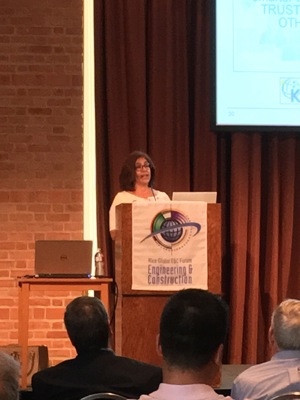Cheniere to become the second-largest LNG operator by 2020
According to Judy Clark, Director, Project Engineering, Cheniere, the LNG operator will become the second-largest LNG operator by capacity by 2020. At present, Cheniere accounts for approximately half of US LNG export capacity in operation or under construction. These facts were discussed during the Rice Global Engineering and Construction Forum (RGF) roundtable. Held monthly on the Rice University campus in Houston, Texas, the RGF roundtable discusses the latest challenges and opportunities facing the contracting side of the global engineering and construction industry.
Ms. Clark’s discussion focused on several challenges that Cheniere faced in developing two LNG sites—Sabine Pass and Corpus Christi—and a sneak peek at the expansion of the Corpus Christi LNG terminal. By 2020, Cheniere expects to have more than 31 MMtpy of LNG capacity operational. This includes five liquefaction trains at Sabine Pass and two liquefaction trains at Corpus Christi. The company is also developing a sixth train at Sabine Pass—FID greenlighted and fully permitted, with a total capacity of 4.5 MMtpy—and a third train at Corpus Christi (completion by 2022), along with an 9.5-MMtpy mid-scale LNG project.
During the construction of Sabine Pass and Corpus Christi, Cheniere faced several engineering and uncontrollable challenges. One of the major challenges was uncontrollable market changes. “When Sabine Pass was built, it was originally set up as an import terminal,” said Mr. Clark, “the onset of US shale gas production completely changed market dynamics for the US LNG industry. This shift led to additional investments in adding new liquefaction trains to the existing facility.”
Additional challenges Cheniere had to overcome at Sabine Pass and Corpus Christi included:
- Geology/poor soil conditions
- Multiple waste management units had to be incorporated (e.g., bauxite disposal area, sludge placement area, non-hazardous waste.)
- Underground distribution piping and other obstacles had to be cleared
- Drainage improvements were needed
- Existing pipelines had to be traversed
- Needed to preserve marine seagrass.
Another major factor was Mother Nature. Both sites were in the path of three hurricanes: Rita, Ike and Harvey. However, neither site succumbed to any major damage. The Corpus Christi site only lost approximately one week of construction time during Hurricane Harvey.
The Corpus Christi site is also being expanded beyond three liquefaction trains. Cheniere plans to begin Phase 3 work (e.g., CCL Stage 3), which includes the construction of seven midscale LNG trains. FID on the project is scheduled for 2020, with operations to begin in 2025. Once completed, Trains 1–7 will have a total capacity of 9.5 MMtpy.

- ExxonMobil halts 1-Bft3d blue hydrogen project in Texas
- Aramco and Yokogawa commission multiple autonomous control AI agents at Fadhili gas plant
- Ukraine will resume gas imports via Transbalkan route in November
- Mitsubishi to inject $260 MM into Brunei LNG project
- Freeport LNG (U.S.) on track to take in more natgas on Thursday after unit outage




Comments